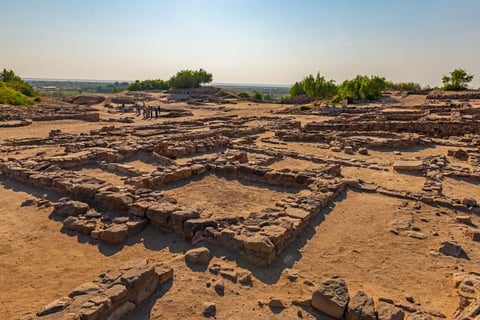Dholavira
Discover the Ancient Marvel
Uncover the Ingenuity and Sophistication of the Indus Valley Civilization




Dholavira
Discovery and History
Discovered in 1967-68 by J.P. Joshi and A.S. Bhasin, Dholavira quickly emerged as one of the most significant Harappan sites, revealing a meticulously planned city with advanced urban infrastructure. The site spans over 100 hectares and is divided into three main parts: the Citadel, the Middle Town, and the Lower Town.
Urban Planning and Architecture
What sets Dholavira apart is its sophisticated urban planning and architectural layout. The city is divided into two parts - the Citadel and the Lower Town - with large walls enclosing the Citadel, highlighting its administrative and possibly defensive significance. The Citadel also contains a remarkable structure known as the "Bailey's Dam," a massive reservoir that once stored water for the city's inhabitants.
The city's streets are laid out in a precise grid pattern, showcasing the advanced town planning skills of its inhabitants. The buildings are constructed using sun-dried mud bricks, with some structures featuring elaborate ornamentation and craftsmanship. The city's drainage system is also noteworthy, with channels and reservoirs designed to efficiently manage rainwater.
Water Management
One of the most impressive aspects of Dholavira is its sophisticated water management system. The city features a series of reservoirs, dams, and canals that were used to collect and store rainwater. The "Bailey's Dam," mentioned earlier, is one of the largest reservoirs and highlights the city's mastery over hydraulic engineering.
Significance and Legacy
Dholavira offers valuable insights into the social, economic, and cultural life of the Indus Valley Civilization. The city's layout suggests a well-organized society with a strong central authority. The presence of unique artifacts, such as seals and pottery, further enriches our understanding of ancient Harappan culture.
Preservation and Tourism
In 1998, Dholavira was designated a UNESCO World Heritage Site, ensuring its protection and preservation for future generations. The site has also become a popular tourist destination, attracting visitors from around the world who come to marvel at its ancient ruins and learn about the Indus Valley Civilization's rich history.
Conclusion
Dholavira stands as a testament to the remarkable achievements of the Indus Valley Civilization. Its well-planned layout, advanced architecture, and sophisticated water management system are a testament to the ingenuity and skill of its ancient inhabitants. As we continue to uncover the secrets of this ancient city, Dholavira remains a fascinating and awe-inspiring destination for anyone interested in the history of human civilization.
